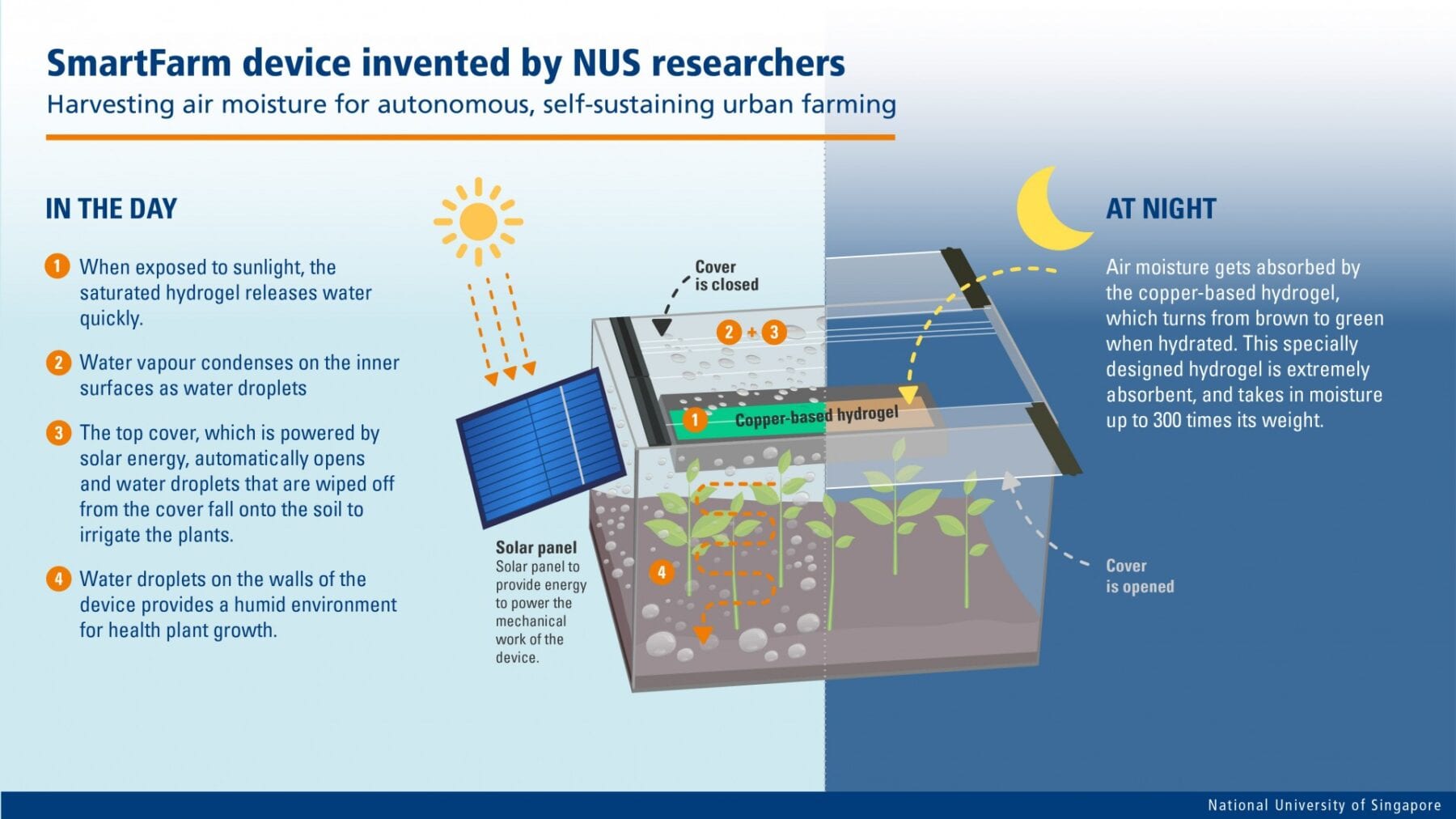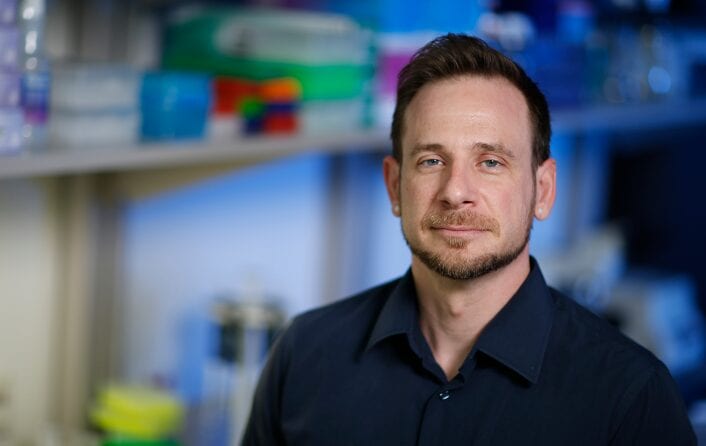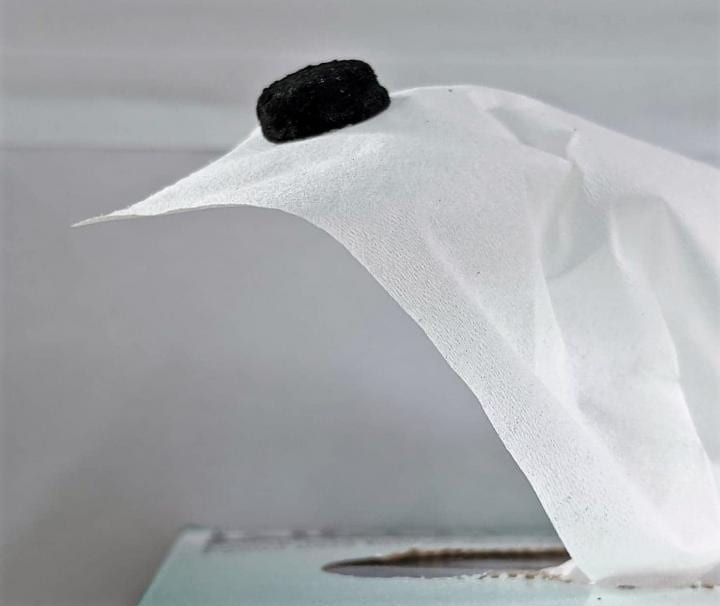
via National University of Singapore
Advanced hydrogel used in SmartFarm also tested for space-based agriculture
A team of researchers from the National University of Singapore (NUS) has recently developed a simple solution to address two of the world’s biggest problems – water scarcity and food shortage. They created a solar-powered, fully automated device called ‘SmartFarm’ that is equipped with a moisture-attracting material to absorb air moisture at night when the relative humidity is higher, and releases water when exposed to sunlight in the day for irrigation.
SmartFarm has another advantage – the water harvesting and irrigation process can be fine-tuned to suit different types of plants and local climate for optimal cultivation. The hygroscopic material that is used in the SmartFarm was earlier tested by Hawai’i Space Exploration Analog and Simulation (HI-SEAS) for its application for humidity control for space-based agriculture.
“Atmospheric humidity is a huge source of freshwater but it has remained relatively unexplored. In this work, we’ve tried to mitigate food and water shortage simultaneously. We created a hygroscopic copper-based material and used it to draw moisture from the air. We then integrate this material into a fully automated solar-driven device that utilises the harvested water to irrigate plants daily without manual intervention,” explained project leader Assistant Professor Tan Swee Ching, who is from the Department of Materials Science and Engineering at NUS.
Novel hydrogel as anchor technology
The key component of the SmartFarm device is a specially designed copper-based hydrogel, which was produced using an economical and time-saving process. This material is extremely absorbent, and takes in moisture up to three times its weight. After acquiring moisture, the hydrogel changes colour from brown to dark green and finally to light green when it is saturated with moisture. It also releases water quickly under natural sunlight – one gram of the copper-based hydrogel releases 2.24 gram of water per hour.
The NUS team also tested the quality of the water that was collected using the copper-based hydrogel, and found that it meets the WHO’s standards for drinking water. Hence, the water collected by the copper-based hydrogel is suitable for drinking and agricultural purposes.
These interesting properties make it attractive for application in the SmartFarm device.
Smart, sustainable urban farming
The SmartFarm device consists of the following:
- a container with a movable top cover
- copper-based hydrogel placed in a flat rectangular tray
- a timer to control the opening and closing of the top cover
- solar panels to harness solar energy to power the mechanical work of the device
- a control panel system to operate the device, including the open and closing of the top cover of the device
- motors and tracks for opening and closing the top cover during irrigation
- acrylic wipers
At night, the top cover opens to allow the copper-based hydrogel to attract atmospheric moisture. In the day, at a pre-set timing, the top cover closes to confine the water vapour allowing it to be condensed on the enclosure’s surface, particularly on the top cover. Water droplets will be gradually formed and when the moisture stored in the copper-based hydrogel is completely released, the top cover automatically opens and water droplets which are wiped off by the parallel wipers fall onto the soil to irrigate the plants. The remaining water droplets on the walls of the device continue to provide a humid environment for healthy plant growth.
As a proof-of-concept, the NUS team successfully cultivated Ipomoea aquatica (commonly known as kangkong, a popular vegetable in Southeast Asia) using the SmartFarm device.
Asst Prof Tan said, “The SmartFarm concept greatly reduces the demand for freshwater for irritation and is suitable for urban farming techniques such as large-scale rooftop farming. This is a significant step forward in alleviating water and food scarcity in the near future.”
“We have also forged a collaboration with HI-SEAS to experiment the application of our hydrogel for humidity control in extra-terrestrial plant growth chambers. We also hope to explore other potential space applications,” he added.
Growing food in space
HI-SEAS is a remote facility located on the lava fields of Hawaii’s Mauna Loa volcano that is designed to simulate long duration missions to the Moon and Mars. Mr Benjamin Greaves, who joined the Selene II simulated Moon mission at HI-SEAS which took place from November to December 2020, used the hydrogel developed by the NUS team to control the humidity in small experimental greenhouses to grow and sustain crops of edible microgreen sunflower plants and upland cress for the mission astronauts.
“These are perfect for space exploration, because we have a very limited amount of space to grow plants up there, but these microgreens are still packed with nutrients, vitamins and minerals,” Mr Greaves said. The hydrogel-cultivated plants provided a welcome fresh supplement to the freeze-dried food supplied for the bulk of the mission.
The HI-SEAS experiments showed that the hydrogels developed at NUS offer a potential low cost, low weight and low energy solution to growing crops in self-sustaining farms.
New functionalities
The NUS team envisage that the SmartFarm device can be further enhanced with additional functionalities before it moves to large-scale and commercial production. For example, a multi-tiered structure could be designed to maximize the utility of rooftop spaces to increase food production, and an air-cooled condenser could be added to the device if the plants are susceptible to temperature.
Furthermore, to guard against prolonged cloudy days, a heating system could be embedded in the container of copper-based hydrogel to provide sufficient thermal energy to activate the water releasing process without sunlight. In addition, the SmartFarm device can incorporate wireless networking capability to enable users to monitor and control the cultivation process using smartphones.
The NUS team is in discussion with commercial partners to explore commercialisation opportunities.
Original Article: NUS researchers create SmartFarm device to harvest air moisture for autonomous, self-sustaining urban farming
More from: National University of Singapore
The Latest Updates from Bing News & Google News
Go deeper with Bing News on:
Self-sustaining urban farming
- Township agriculture programme launched to address food insecurity
In a groundbreaking initiative aimed at addressing food insecurity and uplifting township communities, KwaZulu-Natal Premier Nomusa Dube-Ncube has launched a programme aimed at equipping residents ...
- Community members fight for the future of Southside’s urban farm
A March 27 proposal to the board of commissioners of the Housing Authority of the City of Asheville called for the demolition of Southside Community Farm to make way for a $200,000 outdoor youth play ...
- Column: Symonds On Sustainability, Food & More
Hey Siri turn off low power mode[Opinion column written by OBA Constituency 15 candidate Malachi Symonds] Across Bermuda, a call to action is echoing. With over 90% of all products imported, our ...
- ‘Food security and self-sufficiency a vital necessity’
Across Bermuda, a call to action is echoing. With more than 90 per cent of all products imported, our island stands at a crossroads, facing a future marred by vulnerability, uncertainty and a ...
- NFL provides shed for sustainable farming in Detroit neighborhood
To promote sustainable farming, members of the NFL and officials from the White House took part in a ribbon cutting on Thursday for a GroShed in a Detroit community.
Go deeper with Google Headlines on:
Self-sustaining urban farming
[google_news title=”” keyword=”self-sustaining urban farming” num_posts=”5″ blurb_length=”0″ show_thumb=”left”]
Go deeper with Bing News on:
Space-based agriculture
- New model estimates cultivable space at photovoltaic plants for combining agricultural and photovoltaic production
A team at the University of Cordoba has developed a methodology that defines the cultivable space between two-axis photovoltaic modules, with the aim of promoting the conversion of existing plants ...
- Updated greenhouses will be dream come true for Derry Area agriculture teacher
After a decade leading Derry Area High School’s agriculture/horticulture program, Carly Rippole’s looking forward to summer. The school’s two greenhouses are slated to get an update that includes new ...
- The Diet of Stone Age Hunter-Gatherers Before Agriculture
Researchers found that the hunter-gatherers from Morocco and Libya used to eat wild plants before agriculture.
- What did people eat before agriculture? New study offers insight
The advent of agriculture roughly 11,500 years ago in the Middle East was a milestone for humankind - a revolution in diet and lifestyle that moved beyond the way hunter-gatherers had existed since ...
- Examining the impact of gene-based breeding on agriculture and medicine
A research team has demonstrated that gene-based breeding (GBB) offers a transformative approach to advancing plant and animal breeding, showing remarkable predictability, speed, and ...
Go deeper with Google Headlines on:
Space-based agriculture
[google_news title=”” keyword=”space-based agriculture” num_posts=”5″ blurb_length=”0″ show_thumb=”left”]










